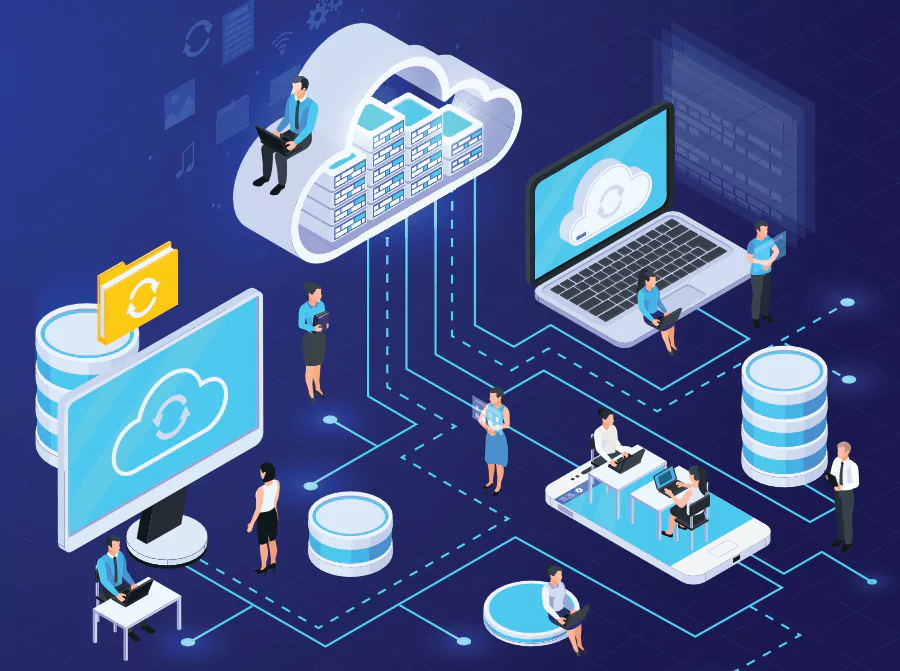Introduction:
Cloud computing has revolutionized the way businesses and individuals store, process, and access data and applications. It offers a range of services and deployment models that cater to different needs and requirements. In this article, we will delve into the various types of cloud computing, exploring their features, benefits, and use cases.

- Infrastructure as a Service (IaaS):
Infrastructure as a Service (IaaS) is a cloud computing model that revolutionizes the way organizations manage and deploy their IT infrastructure. In this model, essential computing resources, including virtual machines, storage, and networking components, are delivered over the internet, empowering users to create and control their IT environments remotely. Here’s a detailed breakdown of Infrastructure as a Service:
Key Features:
- Virtualized infrastructure components (servers, storage, networks)
- Flexible scaling options
- Pay-as-you-go pricing model
- Self-service management capabilities
Use Cases:
- Development and testing environments
- High-performance computing (HPC)
- Disaster recovery and backup solutions
- Scalable web hosting
- Virtualized Computing Resources: IaaS provides access to virtualized computing resources, allowing users to deploy virtual machines (VMs) tailored to their specific needs. These VMs simulate physical hardware, enabling users to run applications, host websites, or perform data processing tasks without investing in physical servers.
- Storage Solutions: IaaS offerings include storage solutions that enable users to store and manage data in the cloud. Users can leverage scalable and reliable storage options to accommodate varying data requirements, ensuring flexibility and cost-effectiveness.
- Networking Infrastructure: IaaS providers furnish networking infrastructure, facilitating the establishment and management of virtual networks. Users can configure network settings, such as IP addresses, subnets, and firewall rules, to ensure secure communication between virtual resources and external networks.
- Self-Service Provisioning: One of the key features of IaaS is self-service provisioning, empowering users to provision and configure computing resources independently. Through web-based interfaces or APIs (Application Programming Interfaces), users can rapidly deploy VMs, allocate storage, and configure networking resources according to their requirements.
- Scalability: IaaS platforms offer scalability, allowing users to scale computing resources up or down dynamically based on demand. Organizations can adjust resource allocations in real-time to accommodate fluctuating workloads, ensuring optimal performance and cost efficiency.
- Pay-As-You-Go Pricing: IaaS providers typically adopt a pay-as-you-go pricing model, where users are charged based on their actual resource consumption. This flexible pricing structure eliminates the need for upfront capital investments in hardware and enables organizations to align IT expenses with usage patterns, optimizing cost management.
- Resource Management and Monitoring: IaaS platforms provide tools for resource management and monitoring, enabling users to track resource utilization, monitor performance metrics, and manage costs effectively. These tools facilitate proactive management and optimization of IT infrastructure, enhancing operational efficiency.
- High Availability and Reliability: IaaS providers ensure high availability and reliability of infrastructure components by leveraging redundant hardware, data replication, and failover mechanisms. This ensures business continuity and minimizes the risk of downtime or data loss, enhancing the overall reliability of IT operations.
- Security and Compliance: IaaS platforms implement robust security measures to protect data and infrastructure from unauthorized access, data breaches, and cyber threats. Providers adhere to industry-standard security practices and compliance regulations, offering features such as encryption, access controls, and threat detection to safeguard sensitive information.
- Disaster Recovery and Backup: IaaS solutions include disaster recovery and backup capabilities, allowing users to replicate data and applications across geographically distributed regions. This ensures resilience against catastrophic events and enables rapid recovery of IT services in the event of disruptions or outages.
In summary, Infrastructure as a Service (IaaS) offers a comprehensive suite of virtualized computing resources, storage solutions, and networking infrastructure delivered over the internet. By leveraging IaaS, organizations can achieve agility, scalability, and cost efficiency in managing their IT infrastructure, driving innovation and competitiveness in the digital era.
- Platform as a Service (PaaS):
Platform as a Service (PaaS) is a cloud computing model that facilitates the development, deployment, and management of applications without the complexities of infrastructure management. It offers a comprehensive platform that includes pre-built services, development tools, and runtime environments, empowering developers to focus on building innovative applications. Here’s a detailed explanation of Platform as a Service:
Key Features:
- Application development and deployment platform
- Built-in development tools and libraries
- Automatic scalability
- Multi-tenant architecture
Use Cases:
- Web application development and deployment
- Mobile application development
- Data analytics and processing
- Internet of Things (IoT) applications
- Complete Development and Deployment Environment: PaaS provides a comprehensive environment for application development and deployment in the cloud. It abstracts away the complexities of infrastructure management, allowing developers to focus solely on the application logic and functionality.
- Development Tools: PaaS platforms offer a wide range of development tools to support the entire software development lifecycle. These tools include integrated development environments (IDEs), code editors, version control systems, debugging tools, and collaboration features, enabling developers to write, test, and debug code efficiently.
- Pre-built Services: PaaS platforms come with a variety of pre-built services and components that developers can leverage to enhance their applications. These services may include databases, messaging queues, caching services, authentication services, and more. By utilizing these pre-built services, developers can accelerate development time and reduce the need for custom coding.
- Runtime Environments: PaaS provides runtime environments that support the execution of applications developed on the platform. These environments include programming language runtimes, middleware components, and application servers optimized for performance and scalability. Developers can deploy their applications to these runtime environments with ease, ensuring consistent performance across different deployment environments.
- Automated Scaling and Management: PaaS platforms often include built-in capabilities for automated scaling and management of applications. They can automatically adjust resource allocations based on application demand, ensuring optimal performance and cost efficiency. Additionally, PaaS platforms handle routine maintenance tasks, such as software updates, patching, and monitoring, freeing developers from administrative burdens.
- Multi-Tenancy and Isolation: PaaS platforms support multi-tenancy, allowing multiple users or organizations to share the same underlying infrastructure while maintaining isolation and security between tenants. This enables efficient resource utilization and cost-sharing among users without compromising security or performance.
- Integration and Interoperability: PaaS platforms offer integration and interoperability capabilities, allowing developers to seamlessly connect their applications with other services and systems. They provide APIs, web services, and integration tools to facilitate communication between applications and external resources, enabling interoperability in complex IT environments.
- Vendor Lock-in Mitigation: PaaS platforms strive to mitigate vendor lock-in by adopting open standards and supporting portability across different cloud environments. They enable developers to build applications using standard programming languages, frameworks, and APIs, reducing dependence on proprietary technologies and easing migration between cloud providers if necessary.
- Security and Compliance: PaaS providers implement robust security measures to protect applications and data hosted on their platforms. They adhere to industry-standard security practices and compliance regulations, offering features such as data encryption, access controls, identity management, and security monitoring to safeguard sensitive information.
- Cost Efficiency: PaaS offers a cost-effective approach to application development and deployment by eliminating upfront infrastructure investments and providing pay-as-you-go pricing models. Developers can scale resources based on demand, optimizing cost management and maximizing return on investment (ROI) for their applications.
- Software as a Service (SaaS):
Software as a Service (SaaS) is a cloud computing model that provides users with access to software applications over the internet on a subscription basis. It offers a convenient and cost-effective alternative to traditional software deployment models, eliminating the need for users to install, manage, and maintain applications on their local devices. Here’s a detailed breakdown of Software as a Service:
Key Features:
- Fully hosted and managed applications
- Subscription-based pricing
- Automatic updates and maintenance
- Broad accessibility
Use Cases:
- Customer Relationship Management (CRM)
- Enterprise Resource Planning (ERP)
- Human Resource Management (HRM)
- Collaboration and productivity tools
- Subscription-Based Access: SaaS delivers software applications to users on a subscription basis, typically charged on a recurring basis (monthly or annually). Users subscribe to the service and gain access to the software through a web browser or dedicated client software, without the need to purchase perpetual licenses or install software locally.
- Centralized Hosting and Management: SaaS applications are centrally hosted and managed by the service provider in the cloud. The provider is responsible for maintaining the underlying infrastructure, managing software updates, ensuring high availability, and addressing security concerns. This relieves users of the burden of software installation, configuration, and maintenance tasks.
- Accessibility and Cross-Platform Compatibility: SaaS applications are accessible from any device with an internet connection and a compatible web browser or client software. Users can access the software from desktop computers, laptops, tablets, or smartphones, enabling flexibility and productivity across different devices and operating systems.
- Ready-to-Use Applications: SaaS offers ready-to-use applications that are fully functional and feature-rich out of the box. Users can immediately start using the software without the need for extensive setup or configuration. This accelerates time-to-value and reduces the time and effort required to deploy and adopt new software solutions.
- Scalability and Flexibility: SaaS applications are inherently scalable, allowing users to scale usage up or down based on changing needs and requirements. Providers offer flexible subscription plans that accommodate varying user counts, feature sets, and usage levels, enabling organizations to align software expenses with business growth and fluctuations in demand.
- Automatic Software Updates: SaaS providers handle software updates and upgrades seamlessly, ensuring that users always have access to the latest features, improvements, and security patches. Updates are deployed centrally by the provider, eliminating the need for users to manually download, install, and manage updates on their devices.
- Data Security and Compliance: SaaS providers implement robust security measures to protect user data and ensure compliance with industry regulations and standards. They employ encryption, access controls, authentication mechanisms, and other security features to safeguard sensitive information and mitigate security risks.
- Customization and Integration: SaaS applications often support customization and integration capabilities, allowing users to tailor the software to their specific needs and integrate it with other systems and services. Providers offer APIs (Application Programming Interfaces), webhooks, and integration tools to facilitate seamless interoperability with third-party applications and data sources.
- Service-Level Agreements (SLAs): SaaS providers typically offer service-level agreements (SLAs) that define the level of service availability, performance, and support guaranteed to users. SLAs specify uptime guarantees, response times for support requests, and other performance metrics, providing users with assurance of service reliability and accountability from the provider.
- Cost Efficiency and Predictability: SaaS offers cost-efficient and predictable pricing models, with subscription fees based on usage, feature tiers, or user counts. Users benefit from predictable recurring expenses, avoiding upfront capital investments and reducing total cost of ownership (TCO) compared to on-premises software deployment models.
- Function as a Service (FaaS):
Function as a Service, also known as serverless computing, allows developers to execute code in response to events or triggers without worrying about the underlying infrastructure. FaaS abstracts away servers and infrastructure management, focusing on executing discrete functions. Developers write and deploy individual functions, and the cloud provider takes care of scaling and resource allocation.
Key Features:
- Event-driven computing model
- Auto-scaling and pay-per-use
- Reduced operational overhead
- Granular function-level control
Use Cases:
- Real-time data processing
- Microservices architecture
- Internet of Things (IoT) applications
- Chatbots and voice assistants
- Desktop as a Service (DaaS):
Desktop as a Service offers virtual desktop environments that are hosted and managed in the cloud. It enables users to access their desktops and applications remotely from any device with an internet connection. DaaS provides a consistent and secure desktop experience, allowing organizations to centralize management and improve data security.
Key Features:
- Virtual desktop infrastructure
- Device and location independence
- Centralized management and security
- Scalable and flexible desktop provisioning
Use Cases:
- Remote work and telecommuting
- BYOD (Bring Your Own Device) policies
- Resource-constrained devices
- Software testing and development environments
Conclusion:
Cloud computing encompasses a diverse range of services that cater to different user needs. Whether you require infrastructure resources, a development platform, fully managed applications, event-driven functions, or virtual desktop environments, the cloud offers a solution. Understanding the various types of cloud computing models is crucial for businesses and individuals to leverage the right services, optimize resource allocation, and drive innovation in the digital era.
Follow Me for regular Updates on LinkedIn; Twitter; Facebook & Instagram for all Technology Articles
View My other Blog posts Here
Join Us on GRK Connect @ Telegram; Discord & LinkedIn Groups for Discussions on Technology


